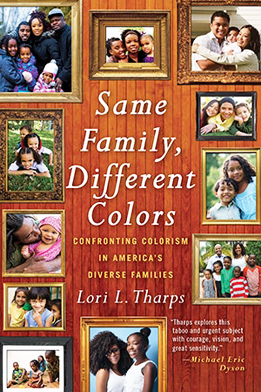|
Same Family,
Different Colors
by Lori L. Tharps
c.2017, Beacon Press
$18.00 / $24.00 Canada
216 pages
By Terri Schlichenmeyer
The Truth Contributor
You debated awhile before you checked the box.
The choices were few: black, white, Latino, Asian, pick one,
tick the box, but that’s not the end of the story. Within
that little square lies a lot more about who you are and who
you feel you are, and in
Same Family, Different Colors
by Lori L. Tharps,
you’ll see that perceptions – yours and that of others -
matter plenty.
Lori Tharps’ youngest daughter is very light-skinned.
|
 |
|
That fact begins her story because it was recently pointed
out by another child in an innocent game – much to that
child’s father’s embarrassment. He needn’t have been
abashed, though: Tharps is African American, her husband’s
family is from Spain, and their children’s skin tone varies.
No big deal.
The outside world seems concerned about things like that,
however. Tharps (and other parents whose kids don’t “match”)
are often asked about racial and cultural identities of
their children, and that can be tiring. The bottom line is
that there are over “one hundred different genes that
influence skin pigmentation” and history is rife with tales
of mixed-race relationships (coerced and otherwise), all of
which explain variations in skin tone and hair between
siblings.
Modern parents generally work to make sure that doesn’t
matter within the family, but Tharps interviewed many black
and Latino adults who grew up with what Alice Walker called
“colorism,” defined as “prejudicial or preferential
treatment of same-race people based solely on their color.”
It affects how children are parented and how they’re taught
in schools; for many adults who grew up with colorism, it
can be devastating.
The good news on the horizon is that “this generation of
millennials” doesn’t seem to like “rules” about skin tones.
Says Tharps, they enjoy a “level of choice” when claiming an
identity – still, there are “limits to the ‘choose your own
identity’ game and not everyone gets to play.”
Cocoa, “paper-bag,” latte, coffee-colored, they’re all brown
– except when they’re not. Parents say it doesn’t matter –
except when it does. In Same Family, Different Colors,
the issue is simple – except when it isn’t.
Author Lori L. Tharps does an admirable job dissecting
issues of prejudice within Asian, Latino and black
communities, but take this as a warning: there’s a lot of
throat-clearing here and it takes awhile to get to the meat
of this book. Once there, you’ll be rewarded by stories of
pain, careful parenting, history and science, and of
everyday people who seem determined to change prejudicial
perceptions but it may already be common-sense to you,
especially if you’ve lived it. Still, though there’s a
sunshine-and-flowers ending here, the overall tone of the
book offers a good bit of hope.
Readers who sigh over incessant racial questions about
themselves or their children may find much food for thought
here. Anyone else wanting to know what to do (or not to do)
in issues of race, color, and appearance will see that
Same Family, Different Colors, now out in paperback,
will check a lot of boxes. |